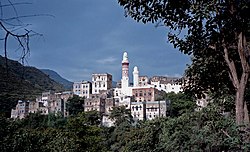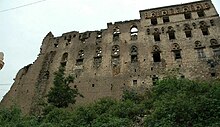Djibla
|
Arabic جبلة, DMG Ǧibla Djibla |
||
|---|---|---|
|
|
||
| Coordinates | 13 ° 55 ' N , 44 ° 9' E | |
| Basic data | ||
| Country | Yemen | |
| Ibb | ||
| ISO 3166-2 | YE-IB | |
| height | 1875 m | |
| Residents | 13,325 (2004 census) | |
|
The facade of the upper town of Djiblas
|
||
Djibla (also: Dhū Jibla or also Dschibbla , Dschiblah and Jiblah ; Arabic جبلة, DMG Ǧibla ) is a small town in Yemen in Ibb Governorate .
City history
The city lies along two rivers and leans on the flanks of a basalt cone of the western mountain slope . Abundance of rain and water sources make the region quite fertile. Fruit and vegetables can be grown without any problems . The name of the city is ascribed to a Jewish potter who worked in Djibla and is said to have been called Jebilah .
From the 15th century, three bridges have been preserved that span both arms of the river. The hillside divides the city into an upper and a lower town. Steep streets connect the city districts. Narrow, lively souks , stately, up to five-storey stone houses and other centuries-old mosques give the town a typical Yemeni character .
Djibla and its surroundings were included in the so-called UNESCO World Heritage Tentative List as a supposed common cultural heritage in 2002 - still without obligation .
Mosque and palace
The importance of Djiblas goes back to the art-historically significant Great Mosque from the 11th century. It was designed as a funerary mosque and was created at the instigation of Queen Arwa bint Ahmad from the Ismaili ruling house of the Sulaihids (1086–1138), who was known for her energetic government business . She was the daughter-in-law of the founder of the dynasty, Ali as-Sulaihi, and after the death of her husband al-Mukarram Ahmad , she moved the seat of government and thus also the Yemeni capital from Sanaa to Djibla, from where she ushered in a glamorous period of government.
The Arwā-bint-Aḥmad Mosque, also Great Mosque , Friday Mosque was built in 1088 AD. Two white filigree brick minarets are prominent . It is a courtyard mosque with a Fatimid prayer hall, which has a raised central nave and several walkways. She represents further Ismaili influences, this is particularly evident in the existing calligraphy and decorations. On the west side, next to the mihrab , which is kept in a purely Fatimid style , is the resting place of the ruler (tombstone). In the Middle Ages, the mosque was a synonym and symbol of Arwa's wisdom and is still considered to be the most magnificent of all the architectural monuments it placed.
The mosque has a valuable library which houses a large number of rare manuscripts on Islam and the Arabic language . Below is a manuscript of the Koran , which is believed to have been written more than 700 years ago. Arwā bint Aḥmad also campaigned for the education of women and encouraged them to do so. The library also provides ample evidence of this, as there are writings written by women. These circumstances gave Djibla the reputation of being a city of spirit, knowledge and science.
The old, formerly four-story, Queen's Palace ( Arwa bint Ahmad Palace ) has crumbled. Arwa bint Ahmad once lived here and made her political decisions in the palace. The palace is said to have consisted of 365 rooms, the model being said to have been the year consisting of 365 days. In order to make potential nocturnal attackers extremely difficult to approach, she is said to have spent every night in a different room. Today there are only two rooms.
Next to the palace there is a museum in honor of the queen, who also raised considerable financial expenses for the construction of vegetable terraces. These still exist today.
literature
- Delia Cortese, Simonetta Calderini - Women and the Fatimids in the world of Islam, 2006, Edinburgh University Press Ltd., ISBN 0-7486-1732-9 .
- Volker Höhfeld : Cities and urban growth in the Middle East - comparative case studies on the regional differentiation of recent urban development processes in the oriental-Islamic culture; Wiesbaden 2005 (= supplement to the Tübingen Atlas of the Middle East, Series B, No. 61)
- Aviva Klein-Franke: The Jews in Yemen in Werner Daum Yemen , Umschau-Verlag, Frankfurt / Main, ISBN 3-7016-2251-5 .
- Aviva Klein-Franke: Tradition and innovation in jewelry production in Yemen in the 20th century , in: Simurgh 1, pp. 19–29, 2005.
- Horst Kopp (Ed.): Geography of Yemen , Dr. Ludwig Reichert Verlag Wiesbaden, 2005, ISBN 3-89500-500-2 .
- Ester Muchawsky-Schnapper: The Yeminites: Two Thousand Years of Jewish Culture , Jerusalem 2000.
- G. Rex Smith: Political History of Islamic Yemen up to the First Turkish Invasion . In: Werner Daum: Yemen . Umschau-Verlag, Frankfurt am Main 1987, ISBN 3-7016-2251-5 , pp. 136-154.
- Werner Daum: Yemen, Umschau-Verlag, Frankfurt / Main, ISBN 3-7016-2251-5 .
Web links
Individual evidence
- ↑ Census December 16, 2004
- ↑ a b c d Jiblah and Queen Arwa
- ↑ Gerhard Heck, Manfred Wöbcke, Arabian Peninsula
- ↑ Photo gallery of the city
- ↑ Views of the old town using the open-map method
- ^ Jibla and its surroundings . whc.unesco.org. Retrieved July 10, 2011.
- ↑ Jenny Walker, Stuart Butler, Terry Carter, Lara Dunston, Frances Linzee Gordon Oman, UAE & Arabian Peninsula
- ↑ Ronald Lewcock: Yemenitische Architektur im Mittelalter, in: Werner Daum: Yemen, Umschau-Verlag, Frankfurt / Main, ISBN 3-7016-2251-5 , p. 203.
- ↑ Long shot of the courtyard of the mosque





